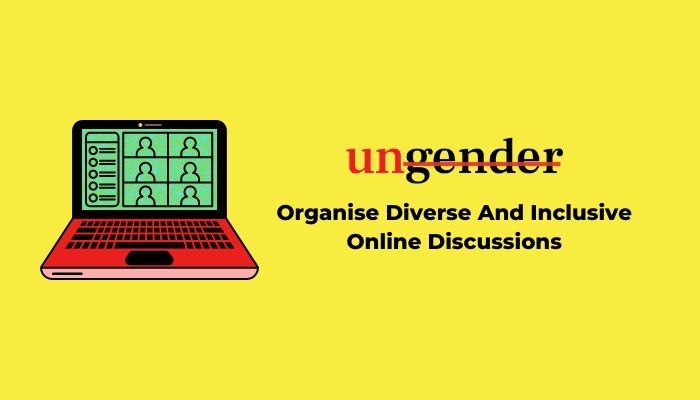Ungender Shares 8 Steps To Organise Diverse And Inclusive Online Discussions

Written By: Pallavi Pareek
This document has been curated to guide any entity about to organize a panel, jury, industry representation, and/or speaker group. Generally, when the aforementioned activities are being planned, organizers subconsciously end up making common mistakes that lead to either a repeat in speakers or a homogeneous speaker set.
There are also times when it is crucial to ensure that sensitivity of the subject on which a specific event is being curated is aligned with the ethos of the members invited for representation. For example, an event on women’s healthcare should definitely not have an all-male panel. Similarly, a conversation on caste shouldn’t have a panel with upper caste folks. A conversation on the ‘Future Of Work’ shouldn’t happen without representation and insights from persons with disabilities.
How to go about curating a speaker set that’s diverse and inclusive?
Step 1: Appoint a diverse team to curate the speaker set. Do not give it to one person or more than one person of the same kind. Have at least three people of different mindsets/backgrounds/expertise to curate the speaker set.
Step 2: Identify the number of members you want to have. It could be any number but start with one.
Step 3: Identify all the stakeholders for the issue you want to have a conversation on. Ensure there’s representation of at least one person and more from as many stakeholder groups as possible. Remember that diversity is not limited to gender alone. One should aim for diversity of age, experience, academic vis a vis practical experience, and so much more. There are about 20+ metrics of diversity that can be brought into context and be represented in the speaker set.
Step 4: Invite nominations/suggestions for the panel from each appointed team member in the organising committee. It would also be good to know, if and how, the team member and nominated professionals are associated. Ask your team members why they have nominated a specific person – it is always good to ask members to highlight the nominated person’s subject expertise.
Additionally, create further diversity by ensuring that you’re not inviting speakers from your first degree of contacts, and only from the second or third degree. In the long run, as an organization, you will end up with a large and diverse network!
Step 5: Sit down with the final list of speakers and do a thorough check. It is always good to read about their work in the field, previous speaking engagements, any published work – the research will help you spot and address any conflicts or contradictions.
For example – If ‘ethics’ is being discussed in a session, you wouldn’t want to have a speaker on the panel who has been accused of unethical behavior in any shape or form in their career. On a panel on workplace sexual harassment, you don’t want to have a speaker who was accused or still under an ongoing investigation.
Step 6: Revisit your speaker list again and see if it has actually come out diverse enough to serve the purpose of inclusive discussion. For any subject which is discussing the “future”, make sure the discussion includes representation from everybody who will possibly be part of the future or isn’t a part of the discourse today and should be.
Step 7: Communicate the intent of conducting an inclusive discussion to your speaker set. Identify topics of discussion that maybe sensitive for a certain speak and/or the audience and clearly set the rules for the discussion. Ensure that you and your speakers find a way to articulate sensitive or triggering information in an appropriate manner. If some aspect of the topic being discussed needs to be avoided, communicate that to your speaker set in advance. An integral element of an inclusive space is respect and dignity for all involved – this includes your audience as well.
Step 8: Keep a log of all the speakers you’ve invited to your events. Until and unless critical, avoid repeating a speaker for at least a year or two. Continue your engagement with them through various other means – social media, emails, newsletters, and the like. Repeating the same set of speakers is in contradiction to the very mission of ensuring diversity that you set out to achieve.
There are a few resources listed at the end of this piece to take you further in your journey of knowing how to go about diversity and inclusion.
There is, of course, a lot more that organisations will have to do to become more diverse and inclusive and Ungender can help with that. Our extended SaaS offering – Conduct – specializes in workplace gender law compliance and inclusion interventions at work. Know more about Conduct, here.
About the author: Pallavi Pareek is the CEO and Founder of Ungender and Conduct.
Ungender Insights is the product of our learning from advisory work at Ungender. Our team specializes in advising workplaces on workplace diversity and inclusion. Write to us at contact@ungender.in to understand how we can partner with your organization to build a more inclusive workplace.
Read our insights about diversity, legal updates and industry knowledge on workplace inclusion at Ungender Insights. Visit our Blog.
Sign up to stay up-to-date with our free e-mail newsletter.
The above insights are a product of our learning from our advisory work at Ungender. Our Team specialises in advising workplaces on gender centric laws.
or email us at contact@ungender.in




